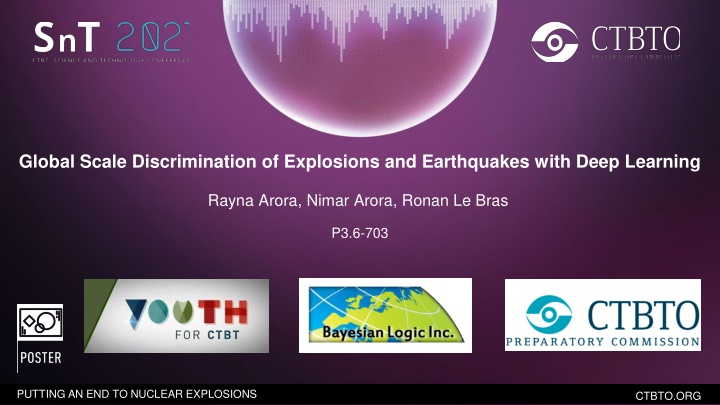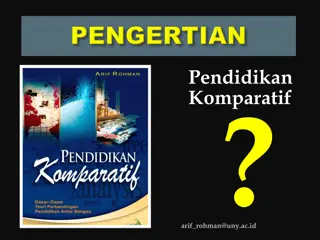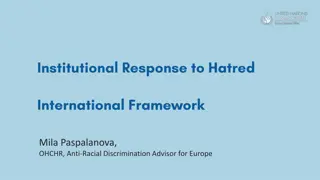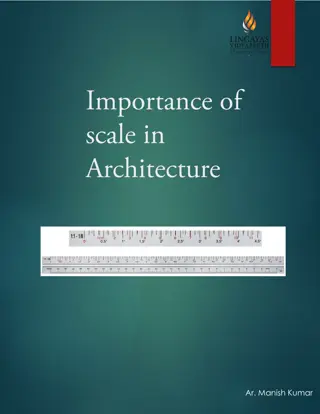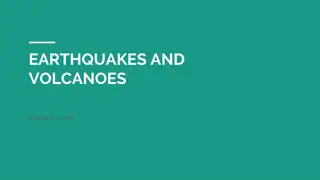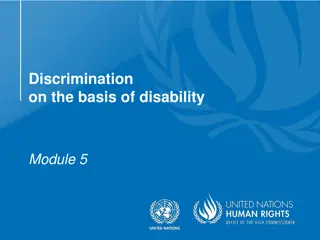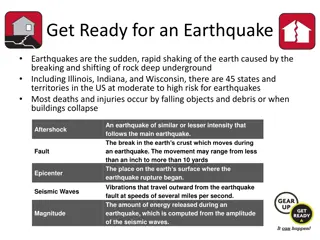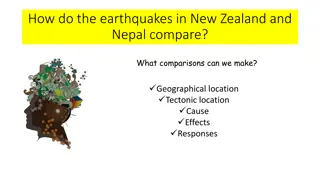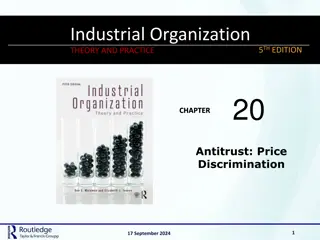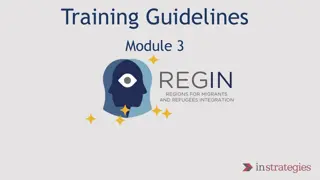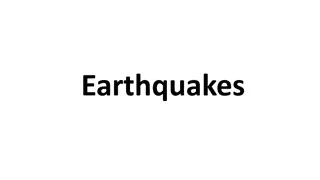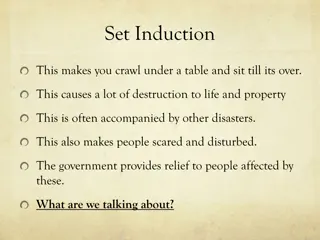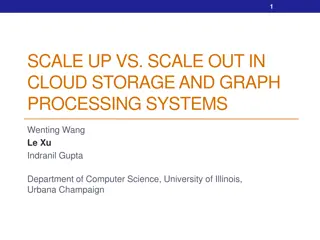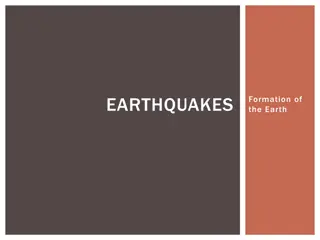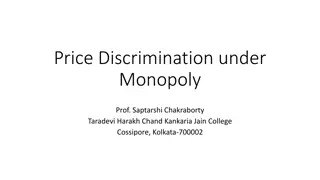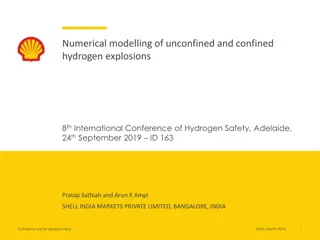Global Scale Discrimination of Explosions and Earthquakes with Deep Learning
Discriminating between explosions and earthquakes is crucial for treaty monitoring and building seismic hazard maps. Research explores using Deep Learning to differentiate seismic waveforms at distances over 20 degrees away, benefiting countries with limited sensor networks. The study presents a new Deep Learning architecture for seismic classification, showcasing generalization capacity on a novel class of explosion-like events. Data from 1978-2018 was collected for analysis. Disclaimer: Views expressed are the author's own.
Uploaded on Feb 17, 2025 | 2 Views
Download Presentation

Please find below an Image/Link to download the presentation.
The content on the website is provided AS IS for your information and personal use only. It may not be sold, licensed, or shared on other websites without obtaining consent from the author.If you encounter any issues during the download, it is possible that the publisher has removed the file from their server.
You are allowed to download the files provided on this website for personal or commercial use, subject to the condition that they are used lawfully. All files are the property of their respective owners.
The content on the website is provided AS IS for your information and personal use only. It may not be sold, licensed, or shared on other websites without obtaining consent from the author.
E N D
Presentation Transcript
Global Scale Discrimination of Explosions and Earthquakes with Deep Learning Rayna Arora, Nimar Arora, Ronan Le Bras P3.6-703 PUTTING AN END TO NUCLEAR EXPLOSIONS CTBTO.ORG
Global Scale Discrimination of Explosions and Earthquakes with Deep Learning Poster No.: P3.6-703 Rayna Arora / CTBTO Youth Group Nimar Arora / Bayesian Logic Inc. Ronan Le Bras / CTBTO INTRODUCTION Discriminating between explosions and earthquakes is necessary for treaty monitoring so that natural events can be screened out by the IDC, and NDCs can forge their own opinions. It can also be useful for building seismic hazard maps. Current research on this topic using waveforms or spectrograms is limited to detections of within 400 km. This isn t applicable in countries with a sparse network of seismic sensors Research Question: Is it possible to use Deep Learning to discriminate between earthquakes and explosions from seismic waveforms detected at over 20 degrees (2000 km) away? Disclaimer: The views expressed on this poster are those of the author and do not necessarily reflect the view of the CTBTO PUTTING AN END TO NUCLEAR EXPLOSIONS CTBTO.ORG
Global Scale Discrimination of Explosions and Earthquakes with Deep Learning Poster No.: P3.6-703 Rayna Arora / CTBTO Youth Group Nimar Arora / Bayesian Logic Inc. Ronan Le Bras / CTBTO CONTRIBUTIONS Developed new Deep Learning architecture for seismic classification from 1D waveforms For comparison purposes, extended existing Deep Learning architectures based on 2D spectrograms to work at over 20 degrees even though they were not designed for these distances. Demonstrated generalization capacity on a novel class of explosion-like events (rock bursts) Disclaimer: The views expressed on this poster are those of the author and do not necessarily reflect the view of the CTBTO PUTTING AN END TO NUCLEAR EXPLOSIONS CTBTO.ORG
Global Scale Discrimination of Explosions and Earthquakes with Deep Learning Poster No.: P3.6-703 Rayna Arora / CTBTO Youth Group Nimar Arora / Bayesian Logic Inc. Ronan Le Bras / CTBTO Data from 1978-2018 was gathered from the ISC Event and Arrival Bulletins[1]and the IRIS waveform repository[2] The dataset consists of 7608 waveform samples Data included equal number of earthquakes and explosions in each distance bucket of 10 degrees from 20 to 180 degrees DATA This dataset is publicly available for future research: https://github.com/RaynaArora/TeleseismicDiscrimination/tree/main/snt2021 [1]Storchak, D.A., Harris, J., Brown, L., Lieser, K., Shumba, B., Verney, R., Di Giacomo, D., Korger, E. I. M. (2017). Rebuild of the Bulletin of the International Seismological Centre (ISC), part 1: 1964 1979. Geosci. Lett. (2017) 4: 32. doi: 10.1186/s40562-017-0098-z Storchak, D.A., Harris, J., Brown, L., Lieser, K., Shumba, B., Di Giacomo, D. (2020) Rebuild of the Bulletin of the International Seismological Centre (ISC) part 2: 1980 2010. Geosci. Lett. 7: 18, https://doi.org/10.1186/s40562-020-00164-6 [2]The facilities of IRIS Data Services, and specifically the IRIS Data Management Center, were used for access to waveforms, related metadata, and/or derived products used in this study. IRIS Data Services are funded through the Seismological Facilities for the Advancement of Geoscience (SAGE) Award of the National Science Foundation under Cooperative Support Agreement EAR-1851048. All seismic data were downloaded through the IRIS Wilber 3 system (https://ds.iris.edu/wilber3/) or IRIS Web Services (https://service.iris.edu/), including the following seismic networks: (1) the AZ (ANZA; UC San Diego, 1982); (2) the TA (Transportable Array; IRIS, 2003); (3) the US (USNSN, Albuquerque, 1990); (4) the IU (GSN; Albuquerque, 1988). Disclaimer: The views expressed on this poster are those of the author and do not necessarily reflect the view of the CTBTO PUTTING AN END TO NUCLEAR EXPLOSIONS CTBTO.ORG
Global Scale Discrimination of Explosions and Earthquakes with Deep Learning Poster No.: P3.6-703 Rayna Arora / CTBTO Youth Group Nimar Arora / Bayesian Logic Inc. Ronan Le Bras / CTBTO Waveforms from 10 seconds before to 80 seconds after first P arrival Highpass filter performed at 1 Hz METHODS Downsampled to 20 Hz Eliminated data without STA/LTA value of at least 2 within 10 seconds of recorded arrival time Waveforms de-trended and normalized Explosion (76 degrees, 5.1 mb) Earthquake (61 degrees, 5.5 mb) Disclaimer: The views expressed on this poster are those of the author and do not necessarily reflect the view of the CTBTO PUTTING AN END TO NUCLEAR EXPLOSIONS CTBTO.ORG
Global Scale Discrimination of Explosions and Earthquakes with Deep Learning Poster No.: P3.6-703 Rayna Arora / CTBTO Youth Group Nimar Arora / Bayesian Logic Inc. Ronan Le Bras / CTBTO Feature Extraction METHODS Sequential Pattern Recognition Produce final prediction Disclaimer: The views expressed on this poster are those of the author and do not necessarily reflect the view of the CTBTO PUTTING AN END TO NUCLEAR EXPLOSIONS CTBTO.ORG
Global Scale Discrimination of Explosions and Earthquakes with Deep Learning Poster No.: P3.6-703 Rayna Arora / CTBTO Youth Group Nimar Arora / Bayesian Logic Inc. Ronan Le Bras / CTBTO fffff RESULTS Disclaimer: The views expressed on this poster are those of the author and do not necessarily reflect the view of the CTBTO PUTTING AN END TO NUCLEAR EXPLOSIONS CTBTO.ORG
Global Scale Discrimination of Explosions and Earthquakes with Deep Learning Poster No.: P3.6-703 Rayna Arora / CTBTO Youth Group Nimar Arora / Bayesian Logic Inc. Ronan Le Bras / CTBTO RESULTS Disclaimer: The views expressed on this poster are those of the author and do not necessarily reflect the view of the CTBTO PUTTING AN END TO NUCLEAR EXPLOSIONS CTBTO.ORG
Global Scale Discrimination of Explosions and Earthquakes with Deep Learning Poster No.: P3.6-703 Rayna Arora / CTBTO Youth Group Nimar Arora / Bayesian Logic Inc. Ronan Le Bras / CTBTO RELATED WORK Mousavi, S.M., Zhu, W., Sheng, Y. et al. CRED: A Deep Residual Network of Convolutional and Recurrent Units for Earthquake Signal Detection. Sci Rep 9, 10267 (2019). https://doi.org/10.1038/s41598-019-45748-1 This research uses a Deep Learning network on spectrograms for P phase detection Results only available for detections within 50 km Linville, L., Pankow, K., Draelos, T. Deep Learning Models Augment Analyst Decisions for Event Discrimination. AGU Geophysical Research Letters (2019). https://agupubs.onlinelibrary.wiley.com/doi/full/10.1029/2018GL081119 This research tests a Convolutional Neural Network(CNN) and Recurrent Neural Network(RNN) on spectrograms for discrimination between earthquakes and quarry blasts. Results only available for detections within 400 km. Both methods require many more parameters because they process 2D spectrograms rather than 1D waveforms. Disclaimer: The views expressed on this poster are those of the author and do not necessarily reflect the view of the CTBTO PUTTING AN END TO NUCLEAR EXPLOSIONS CTBTO.ORG
Global Scale Discrimination of Explosions and Earthquakes with Deep Learning Poster No.: P3.6-703 Rayna Arora / CTBTO Youth Group Nimar Arora / Bayesian Logic Inc. Ronan Le Bras / CTBTO RELATED WORK Models from related work were reproduced and trained and tested on the corresponding spectrograms for the dataset of our proposed method. Model Best Accuracy AUC Parameters Proposed Method 89.5% 0.962 96,641 Mousavi et al. (CRED) 0.957 208,273 89.7% Linville et al. CNN 83.9% 0.896 456,237 Linville et al. RNN 80.9% 0.894 375,425 Disclaimer: The views expressed on this poster are those of the author and do not necessarily reflect the view of the CTBTO PUTTING AN END TO NUCLEAR EXPLOSIONS CTBTO.ORG
Global Scale Discrimination of Explosions and Earthquakes with Deep Learning Poster No.: P3.6-703 Rayna Arora / CTBTO Youth Group Nimar Arora / Bayesian Logic Inc. Ronan Le Bras / CTBTO RELATED WORK Rock Burst Results Rock bursts are spontaneous explosive ejections of rocks in mines caused by high stress. Our model was not trained on rock burst data, but a separate test was performed to assess how well the model generalizes Rock bursts were treated as explosions Our model obtained 96.7% accuracy on over 2000 rock burst waveform samples A Proposed Method B CRED C Linville et al. CNN D Linville et al. RNN Disclaimer: The views expressed on this poster are those of the author and do not necessarily reflect the view of the CTBTO PUTTING AN END TO NUCLEAR EXPLOSIONS CTBTO.ORG
Global Scale Discrimination of Explosions and Earthquakes with Deep Learning Poster No.: P3.6-703 Rayna Arora / CTBTO Youth Group Nimar Arora / Bayesian Logic Inc. Ronan Le Bras / CTBTO Deep Learning methods work well for discriminating between earthquakes and explosions on waveforms detected at teleseismic distances (over 20 degrees / 2000 km), yielding ~90% accuracy despite limited data CONCLUSIONS Using seismic waveforms rather than spectrograms as model inputs, it was possible to train a model with far fewer parameters that generalizes better for unseen inputs such as rock bursts Future Work: Test on CTBT data Apply to Phase identification Apply to detection Disclaimer: The views expressed on this poster are those of the author and do not necessarily reflect the view of the CTBTO PUTTING AN END TO NUCLEAR EXPLOSIONS CTBTO.ORG
